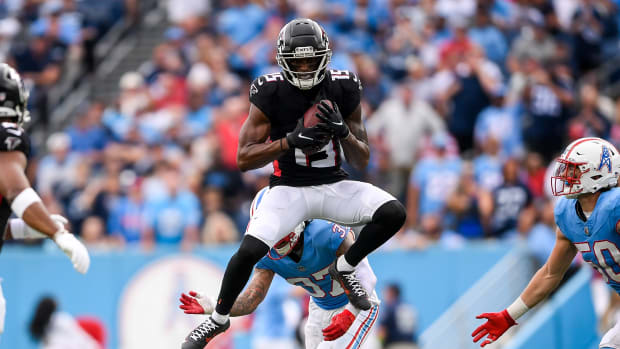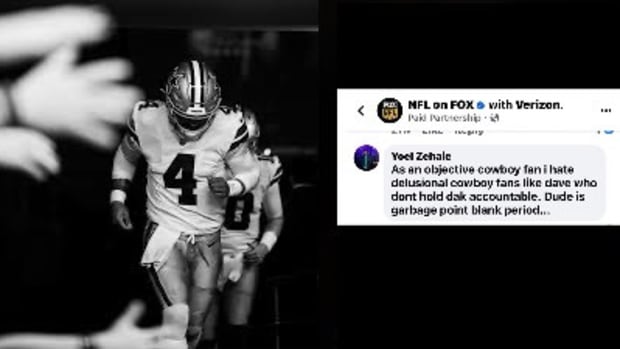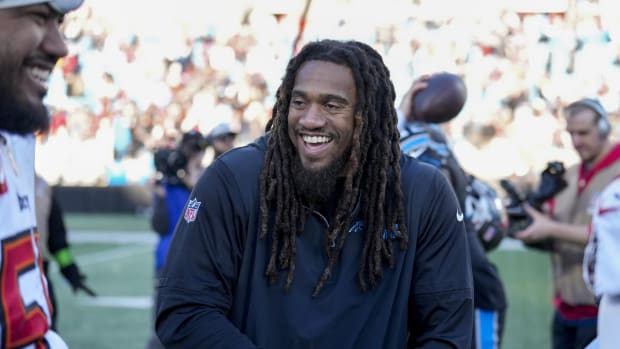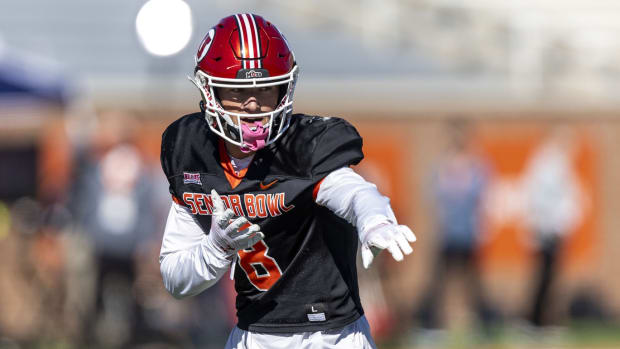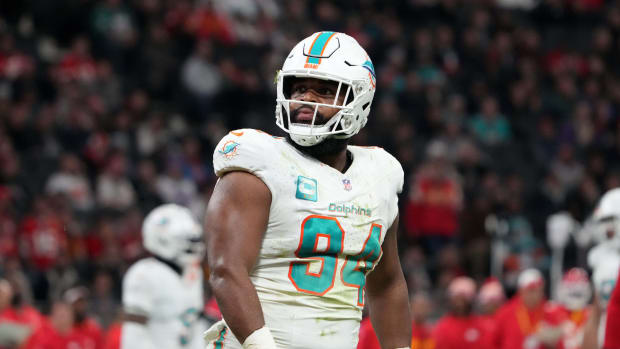Finally content in retirement, Favre preps for his next Lambeau moment
Brett Favre grabs a random football from his memorabilia room and climbs inside a Silverado pickup with mud stains on the floorboards, dog-paw-shaped garage door openers clipped to the visor and a .22 rifle nestled under the backseat. “For varmint, mostly,” he says.
You have reached your limit of 4 premium articles
Register your email to get 1 more
Hazards abound on Favre’s 465-acre estate in Sumrall, Miss. Rattlesnakes with poisonous fangs. Ravenous wild hogs with snouts that dig craters. Floods from heavy rains. Even the rare tornado, like the one in 2003 that ripped the barn roof off above Favre’s head, threw a trailer into a lake and uprooted some 180 pine trees.
The pickup banks right, into the woods, away from the mansion, the pool, the guest house and the sand volleyball court, past two unnamed lakes, each with its own fountain. Favre doesn’t give visitors an address. He sends coordinates to the property, which resides at the intersection of nature park and retirement hideaway. “Watch out for ants,” Favre says, as he parks. “They’ll eat you alive.”
It’s 9:35 a.m. on a Tuesday in March, more than four years into Favre’s retirement. Not the first retirement, or the second (loosely speaking), or even the third, but the fourth—the one that seems to have stuck. Fortified by gluten-free biscuits he made that morning, Favre grabs the football and swats at mosquitoes and loosens his right arm.
• Where Are They Now: From Favre to Harris, all our throwback coverage
His dog, an 11-year-old chocolate lab named Sam, follows, wet from a morning swim. She had a tumor removed the week before and requires daily insulin shots; she can no longer gobble pancakes or bacon the way she once did. Her whiskers, like Favre’s hair, have turned gray. She’s old, and that only reminds Favre that he is getting older, ensconced in middle age now: 45, or roughly halfway between the end of his career and an AARP membership. Teammates once called him Grandpa. Now, he is one—a grandfather to two boys, Parker and AJ.
Over 20 NFL seasons, sometimes it seemed as if Favre would never grow up, let alone grow old. He thrilled and scrambled and improvised and, before one important drive, paused to goofily advise coach Mike Holmgren of an icicle in his mustache. Favre never took himself too seriously. He lined teammates’ helmets with Vaseline and baby powder, laced jockstraps with Icy Hot cream, dumped buckets of water on unsuspecting heads. He read aloud from You Might Be a Redneck If . . . on the way to playoff games. He was the opposite of fine wine: He never aged. Until he did.
Favre grabs the football—“slightly deflated,” he jokes; “we better not go there”—and slings passes that whistle through the woods. The three MVP awards, the two Super Bowl appearances, the trove of records broken, the past life—it all floods back. This is Favre’s reunion season, anyway. Time to remember what’s important, and to forget how it all ended in Green Bay. On July 18, the prodigal quarterback will have his number 4 retired and be inducted into the Packers’ Hall of Fame. He will return to Lambeau Field for the first time since 2010, when, in his second season with the Vikings, he fell to his former team while his former fans showered him with boos.
“I think I could play,” Favre says later, out by the pool. “As far as throwing, of course. I could make all the throws I made before.”
He pauses, because he knows it’s one thing for any retired QB to make such statements and quite another for them to come from Brett Lorenzo Favre. “We’re not trying to start some he’s-coming-out-of-retirement deal,” he says.
Brief pause.
“But I could play.”
*****
On Dec. 20, 2010, in Week 15 of an already lost season, Favre’s 5–8 Vikings hosted the Bears at TCF Bank Stadium, their temporary home after snow collapsed part of the Metrodome’s roof. “I shouldn’t have been playing,” Favre says. “I had a hurt collarbone. Typical me: Nothing to gain, but I wanted to play.”
He dropped back on third down in the second quarter. He never saw defensive end Corey Wootton close in and bury him from behind, never felt his head bounce off the frozen turf. “Next thing you know,” Favre says, “I’m snoring.”
He spotted trainer Eric Sugarman, who told him,“Come with me.”
“Why are the Bears here?” Favre asked. He took two steps toward Chicago’s sideline.
Catching up with the dogs of Sochi
Sugarman escorted Favre into the locker room, where the QB showered, drank hot chocolate and ate a hot dog. That was both his last play and, he says, the exact moment that he knew he would retire. Not should. Would. “From that point on, I never missed it,” Favre says. “I knew it was time.”
The end.
Believe that at your own risk, history suggested. Favre turned retiring—and unretiring and retiring again—into an art form, an annual (and annoying) reality show broadcast live every off-season. To his copious records he would add a strange first: first quarter-back in NFL history to lead three different teams (Packers, Jets, Vikings) to winning records in three straight seasons and retire after each of those seasons and come back after each of those retirements. Break that record, Peyton Manning.
The signs were there, in hindsight. The euphoria after wins had vanished. In that 20th season, his last, Favre sometimes considered staying down when defenders flattened him. In December, against the Bills, he landed chest-first after one vicious blow and thought, That one’s going to stay with me. He had never thought that way before.
His former coach and friend, Steve Mariucci, asked Favre all the time, “Why do you keep playing? What do you have left to prove?”
• KING: Looking back on the Favre-Packers divorce in 2008
“Because I can still play,” Favre always responded.
Still, Mariucci urged him to retire. “The only thing you have left to prove is that you can let go,” he said.
It wasn’t just the hits that were getting to Favre. It was the Packers’ decision to wave goodbye after the 2007 season, which still gnawed at him three years later. The repeated summers of contemplation and anxiety. The repeated relocations for his family. The Favre Watches and the jokes. The on-field frustrations, like the torn right biceps that sank an 8–3 start with the Jets in ’08, or the fourth-quarter interception that cost the Vikings a Super Bowl appearance in ’09. The off-field distractions: an ’08 NFL investigation into whether Favre had sent inappropriate text messages to a game-day hostess for the Jets, and the lawsuit filed by two Jets massage therapists who made the same claim. (The investigation was inconclusive, and the lawsuit was settled in ’13.)
Chairmen of the Cardboard: Recreating memorable trading cards
The signs pointed toward a most un-Favre-like conclusion: The quarterback who seemed he might play forever had begun to wear thin. And, after more than 300 NFL starts, there was concern about his future. “No one’s invincible,” Favre says. “Things do catch up with you. There is a price to be paid. What that will be is yet to be seen. It may be from one violent hit. I don’t know, but it’s scary. Because you wonder, you can’t help but wonder, what is that going to do to me? Or am I going to be one of the lucky ones? Whatever lucky is. I’m not knocking the NFL. I knew what I signed up for. I could have got out whenever I wanted to get out.”
All that, Favre says, seems like a million years ago—another guy in another life. He has seen that guy, on television. “I don’t study my retirements,” he says. “But I have watched them. I look at them the way I do old pictures. Like, Oh my gosh. That haircut.”
On the first Sunday of the 2011 season, his first out of the league in 21 years, Favre cut grass and cleared brush at his property. His wife, Deanna, called him inside. The Vikings game was on. Favre had figured he would miss football, but he did not. He watched the game and went back outside and woke up Monday morning free from soreness.
At the end of last season he watched Manning’s descent into Favrelandia. An injury. A playoff loss, quickly followed by all the retirement questions. Favre always hated to address his future in the moments after a season ended. He loathed football in those moments. “Better him than me,” he thought.
*****
[pagebreak]
Favre arrives at his local grocery store with a shopping list: paper towels, syrup, pancake mix and chips for his youngest daughter, 15-year-old Breleigh. At the checkout line, the clerk asks, “Are you someone famous?”
“I don’t know,” Favre says.
“Well,” the clerk says, “you look like someone famous.”
“Would someone famous shop in here?”
The clerk steals a glance at the bagger. “You’re right,” she says. “Nobody famous would be in here.”
Anthony Hargrove remains in football exile years after Bountygate scandal
“Justin Bieber wouldn’t shop here,” the bagger chimes in.
Favre laughs. He relishes any moments of anonymity. Sometimes someone will recognize him only from his cameo in There’s Something About Mary. “You’re Brett Farv-ruh,” they’ll say, a nod to how Ben Stiller’s character mispronounced his last name. “I can’t tell you how much I appreciate that,” he’ll respond.
Favre did not make any master plan for life after football. He approached retirement the same way he approached the game itself: He winged it. As he fiddled around each morning, he listened to books on tape, mostly self-help volumes about how to better parent or how to clean his showerhead or how to fix a cabinet. He coordinated the offense for a high school football team over two seasons. He turned down offers from at least 10 reality television shows and Dancing with the Stars. He played sand volleyball, poorly. He cooked breakfast, experimenting with different recipes after discovering dairy, gluten and soy allergies. “Sucks getting old,” Favre says.
He followed Deanna (who defeated breast cancer in 2005) around the country as she climbed mountains and competed in half Ironman races and triathlons. He visited national parks—Glacier and Yellowstone. He skied in Colorado, Montana and Utah. He made more than 30 trips to Disney World, still the boy who never quite grew up.
Favre stills films the occasional commercial, for Wrangler jeans, Copper Fit or Foot Locker. He acts as a spokesman for Sqor Sports, a social media company. But mostly, he says, “I just want to hide on my property and not do anything.”
Away from the male-dominated world of professional football, Favre is surrounded by women now. Deanna, 46, and Breleigh live with him. His mother-in-law, Ann Byrd, lives on the property. His elder daughter, 26-year-old Brittany Favre-Mallion, graduated in May from Loyola Law, in New Orleans. Even Sam, the lab, is female. “Deanna is in charge of everything, best I can tell,” says John Karnes, Favre’s friend and property manager.
Favre does enjoy more stereotypically manly pursuits. When his wife and daughters finish American Idol and The Voice, he stays awake for Mountain Men and Ax Men and Swamp People and Ice Cold Gold, of which he gushes, “They’re over there in Greenland! Badass! And Gold Rush. I love Gold Rush!”
He still hunts. “About like he breathes,” says J.D. Simpson, another Favre friend and his pastor. Deer in the fall. Wild turkeys in the spring. Trips to the Delta, Montana, New Mexico and Kansas, where he bagged a nine-point buck last football season. “He’s not a hermit,” Karnes says.
Ex-Bears star Tommie Harris finds second act after unexpected tragedy
In fact, most days Favre the Fundraiser solicits donations. He helped raise $2 million for a new football complex at Oak Grove High, where he coached, in nearby Hattiesburg, after a tornado ripped apart the old one. Then he turned his attention toward a new volleyball complex, for which he has reached about $800,000 of his $1.1 million goal.
One beneficiary of that complex will be Breleigh, a volleyball star at Oak Grove, where she’ll be a junior in the fall. Favre travels throughout the Southeast for her tournaments and drives her to practices for her select team in Daphne, Ala., two hours away. He describes himself as a quiet spectator in the stands, but it’s a struggle balancing his own drive with the restraint required of a parent.
Favre’s father, Irvin, rarely doled out compliments in his decades as a coach, and Favre guards against his natural instinct to instruct Breleigh the way Big Irv did him. He wants her to practice longer, with more intensity. She sometimes rolls her eyes at him. He wants to provide constructive criticism. It doesn’t always come across that way.
Favre leaves reminders to himself on his cellphone. Be sure to encourage. Be positive with your kids. But sometimes he can’t help himself. “If you say you’re going to work on your jump serve, let’s work on it,” he’ll say.
Another eye roll.
“You’d think [Deanna and I] were never competitive in anything,” Favre says.
*****
Favre pulls his truck back into the driveway and rolls down the window to speak with his adolescent nephew Casey. They make plans to play catch later, and Favre admits that their last session resulted in a sore elbow. “Getting old, son.”
“Uncle Brett has joint problems,” Casey deadpans.
Favre nods. He started 321 consecutive NFL games, including playoffs, the record of all records, and he suspects that all the hits and throws and practices—combined with the four years he started in college and a car crash that left his insides wrecked before his senior season—will eventually exact their toll. “I didn’t do myself any favors, the way I played,” he says.
He suffered his worst concussion on the last play of his career. Another one earlier that season, in New England, left him seeing fireworks and needing 10 stitches to close a chin gash. Dings? Dizziness? Bell rung? “Duh,” Favre says, sounding older than ever. Over 20 seasons, he lost count.
Favre does not resent the game that left him battered, sore, racked with pain on Monday mornings. Over his career the average size of NFL players at every position ballooned. He came to expect bigger hits—and he took them. He watched former teammates, like backup quarterback Jim McMahon, descend into memory loss, and worse. And yet, while Favre sometimes forgets where he’s left his car keys or his sunglasses, he is almost pain free, save for that joint soreness.
He wonders about the years ahead. No quarterback played more games than Favre, or suffered more blows. He had surgery on both ankles, his right elbow, his right shoulder and his right biceps, twice. His cumulative hits number in the thousands. That worries him. “It’s scary,” he says. “I mean, nothing shocks me anymore. I never thought I’d see Jim McMahon like that. He was invincible.”
Favre can still heave a football 50 yards, about 30 fewer than at his peak. In his first year away from the game he gained 25 pounds, stuffing himself with chocolate lava cakes, brownies and ice cream. He weighed 248 the day in 2011 he decided to enter a 5K run. He lasted all of 70 yards and finished the race, walking, in a Gilbert Brown–esque 48 minutes. But he kept at the jogging until he could plod four miles around his property, and he took up cycling and started to pay attention to his diet. When his family traveled, he took early-morning runs around Seattle and Park City and New Orleans. One morning in the French Quarter, he passed a drunk on Bourbon Street. “You’re Brett Favre!” the man shouted.
Those pursuits replaced football, and Favre insists that when he let go, he let go almost completely. He says he doesn’t own a jersey, he doesn’t watch many games. What memorabilia he has is confined to one small room.
Favre doesn’t want to serve as some sort of elder statesman. He doesn’t want to opine on Tom Brady and Deflategate, although he doesn’t think flattened balls helped Brady much (even while he says he never directly communicated with his own equipment managers the way Brady did).
Another nephew, Max, does play football. Favre has no issues with that choice. He wants better treatment for concussions, more research. But change football? “I wouldn’t,” he says. “Other than the tackling. It’s terrible.”
*****
Favre parks his truck in front of the South Mouth Deli in early June for breakfast. “It was either here or Cracker Barrel,” he says before ordering gluten-free French toast, fruit and a Coke.
That the Packers will retire Favre’s number 4 jersey and induct him into Green Bay’s Hall of Fame dominates the conversation. He’s excited about the ceremony and moved by the fans’ interest, especially by how Lambeau Field’s lower bowl sold out—67,000 seats—so that diehards could watch Favre’s induction on the big screen. The ceremony itself will take place in a nearby atrium.
“I was blown away,” Favre says. “I mean, it’s not Elvis, but it feels that way. Like Elvis is coming back for one last show.”
Favre grew up in Green Bay. Or tried to. He jumped on the backs of so many teammates after touchdowns that Holmgren threatened to fine him $5,000 for his next leap. He babysat Mariucci’s children, but “after a while, they didn’t want that anymore,” Mariucci says. “He kept giving them the Dutch oven.”
A scout named Ted Thompson joined the Packers in 1992, the same year Favre was acquired in a trade with the Falcons. Sometimes the two retired to the Fifty Yard Line, across the street from Lambeau, and downed a pint or three. Back then, Thompson says, the Packers struggled not only to win but also against the notion that players didn’t want to come to Green Bay.
Favre changed that. Thompson recalls the afternoon Favre replaced an injured Don Majkowski against the Bengals on Sept. 20, 1992, and threw a last-second touchdown for a comeback win. Oh, boy, Thompson thought. This must be it.
Over beers at the NFL combine, counterparts would warn Holmgren that Favre was going to get him fired. But Holmgren and Favre worked in an odd-couple sense. Favre even listened. Sometimes.
After three consecutive 9–7 seasons, with a 2–2 record in the postseason, Favre approached Holmgren on the team plane after a playoff loss. “I finally get it,” he said. And he was right. He won those MVP awards and a Super Bowl in 1997 and an NFC championship a year later. On the field after their Super Bowl triumph, Holmgren told Favre that he loved him. The coach, nonetheless, left for Seattle in ’99. “I can’t help but think that if Mike had stayed, they would have won another Super Bowl or two,” Mariucci says.
Favre never expected to leave. He never wanted to. “I remember when that whole Joe Montana deal unfolded,” he says, recalling the Hall of Famer’s unceremonious departure from San Francisco. “When he went to the Chiefs, I’m like, You’ve gotta be kidding me. If it can happen to Montana, it can happen to anyone.”
Giants cornerback Corey Webster intercepted Favre’s last pass as a Packer, in overtime of the 2008 NFC title game. That’s when the melodrama started. Favre says that he felt pressure from Green Bay to make an immediate decision on whether he wanted to retire. He believes that Thompson, by then the general manager, wanted to hand the reins to Aaron Rodgers, Favre’s backup then (and now arguably the best player in football). Favre retired for the first time. Four months later he unretired. “Had I [taken my time deciding], I would have come back and played,” Favre says. “The drama would have been avoided.”
The Packers refused to grant his release. Instead, they traded Favre to the Jets. After one season in New York he retired and unretired, landing next with the Packers’ NFC North rivals, the Vikings, in 2009. Still angry, Favre beat his former team twice that season. The crowd at Lambeau showered him with boos and death threats as Favre, wearing purple, threw four touchdowns in his Lambeau return. After both wins, Favre received text messages from an unlikely source. “Great job,” one read. “You played outstanding,” said another.
The texts came from Thompson, and to Favre they represented the first step toward reconciliation. “That was positive,” Favre says, “whereas, when I left, I felt like they did this media bash to make their decision look right and mine look wrong.”
Favre had always identified as a Packer. He hoped the fans felt the same way. “He needed peace,” Simpson says. “It hurt him how the process went.”
In particular, Favre believes his relationship with Rodgers has been mischaracterized. “We got along fine,” he says, “regardless of what you’ve heard.
“Look,” he continues, “when I was on the sideline as a backup, I would be like, I kind of hope [the starter] gets hurt. But not bad. I just wanted to get in. I couldn’t believe I was pulling for somebody to get hurt. Then, when I used to lay on the ground, it crossed my mind that those guys behind me feel the same way.”
Favre wants the public to believe that all the tension and hard feelings have smoothed out over time. Maybe that’s true, or maybe he just doesn’t want to talk about it. Now, he wants to focus on the Hall induction, and a second Lambeau ceremony scheduled for November, and not the Packers’ refusal to let him host his charity flag football game at the stadium.
As for the ceremony, “I expect him to cry a lot,” Karnes says. “He’s pretty big on crying on national TV.”
*****
Favre received an unexpected request this spring. It came from Nevil Barr, the longtime football coach at Oak Grove, who wanted to ask Favre about . . . retirement. “You sure you want to ask me about that?” Favre joked. “I could write a book about that. How to—and how not to.”
Favre told him the same thing he tells anyone who asks, including former teammates like Donald Driver: If you wonder what might happen if you keep going, then don’t retire. As bad as that final Vikings’ campaign was—11 touchdowns, 19 interceptions—it answered a question that otherwise would have lingered: Could that team win a Super Bowl? (No, it turns out.) Favre may not have liked what he learned, but he answered every question, and that, he says, is what enabled him to finally let go.
“He’s the poster child for what every athlete feels,” says Ken Ruettgers, another former Packers teammate who now runs a program that helps athletes transition into retirement. “For that inner turmoil. For the desire to still play.”
As the ceremony approaches, Favre pulls on a Packers jersey for a Sports Illustrated photo shoot—the first time, he says, that he’s worn the dark green number 4 since that title game in 2008. A photographer snaps away, Favre with a football in his hands and Sam resting at his feet. He has already started writing the speech, waking up at 2 a.m. to jot down notes on his iPad. “I don’t want to leave anything out,” he says. “But I don’t want to ramble. I don’t want, He’s already said that. My gosh, he must have a brain injury or something.”
Favre calls himself the world’s best rambler. He’ll start a story about his daughter’s volleyball practice, pivot to the time that he asked pro volleyballer Kerri Walsh Jennings to call Breleigh, and wind through the time he tried (and failed) to get Breleigh backstage at a Maroon 5 concert—and finally he’ll get to the point, which is that Breleigh may play volleyball in college. But not without an interlude about his bicycle crash one week earlier, the story behind the scabs that cover his left elbow, knee and shoulder. That and how the geese nearby are Canadian.
“I never followed a script,” Favre says, and that applies to his career and his life and his retirement. Which is exactly how he left Green Bay and wound back to return this summer as a Packer among the greatest Packers, alongside Vince Lombardi and Bart Starr, Holmgren and Reggie White.
“That’s how he should be remembered,” Holmgren says. “As a Packer.”
One day after the photo shoot, Favre stops by Oak Grove High for a workout with a college quarterback he mentors, but rain washes out the session. He is asked if he felt even a hint of nostalgia when he pulled on that Packers jersey a day earlier. “It was so big on me,” Favre says. “It felt like a nightgown.
“That’s not my world anymore,” he adds.
Favre climbs in his truck and points back toward his estate, where the previous afternoon he managed to get two tractors stuck in mud surrounded by high brush, where the rattlesnakes lurk. He drives past the construction for the volleyball complex, away from the football field. This time, he will not turn back.

































